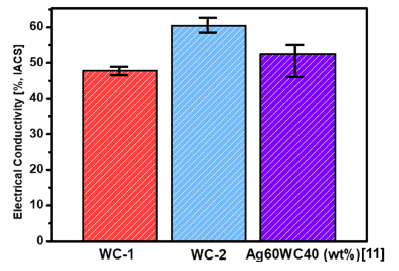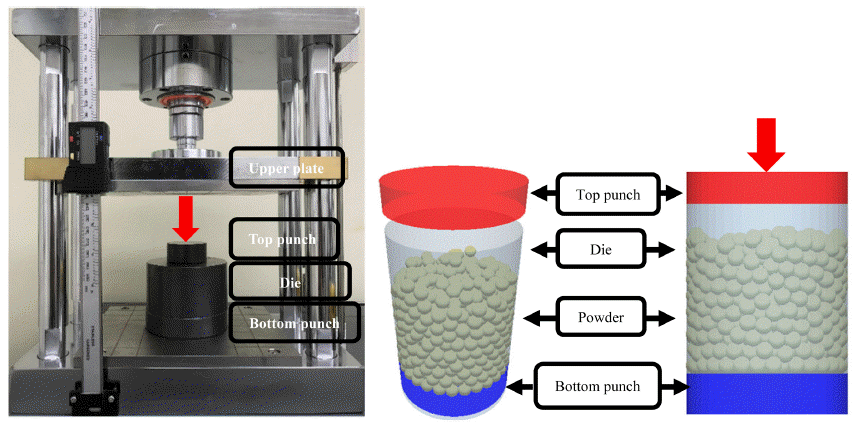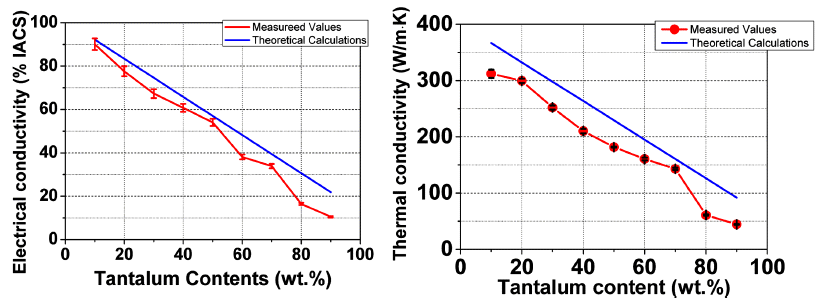Search
- Page Path
- HOME > Search
- [Korean]
- Effect of WC Particle Size on the Microstructure, Mechanical and Electrical Properties of Ag/WC Sintered Electrical Contact Material
- Soobin Kim, So-Yeon Park, Jong-Bin Lim, Soon Ho Kwon, Kee-Ahn Lee
- J Powder Mater. 2023;30(3):242-248. Published online June 1, 2023
- DOI: https://doi.org/10.4150/KPMI.2023.30.3.242

- 772 View
- 3 Download
- 1 Citations
-
 Abstract
Abstract
 PDF
PDF The Ag/WC electrical contacts were prepared via powder metallurgy using 60 wt% Ag, 40 wt% WC, and small amounts of Co3O4 with varying WC particle sizes. After the fabrication of the contact materials, microstructure observations confirmed that WC-1 had an average grain size (AGS) of 0.27 μm, and WC-2 had an AGS of 0.35 μm. The Ag matrix in WC-1 formed fine grains, whereas a significantly larger and continuous growth of the Ag matrix was observed in WC-2. This indicates the different flow behaviors of liquid Ag during the sintering process owing to the different WC sizes. The electrical conductivities of WC-1 and WC-2 were 47.8% and 60.4%, respectively, and had a significant influence on the Ag matrix. In particular, WC-2 exhibited extremely high electrical conductivity owing to its large and continuous Ag-grain matrix. The yield strengths of WC-1 and WC-2 after compression tests were 349.9 MPa and 280.7 MPa, respectively. The high yield strength of WC-1 can be attributed to the Hall–Petch effect, whereas the low yield strength of WC-2 can be explained by the high fraction of high-angle boundaries (HAB) between the WC grains. Furthermore, the relationships between the microstructure, electrical/mechanical properties, and deformation mechanisms were evaluated.
-
Citations
Citations to this article as recorded by- Enhanced Epoxy Composites Reinforced by 3D-Aligned Aluminum Borate Nanowhiskers
Hyunseung Song, Kiho Song, Haejin Hwang, Changui Ahn
Materials.2024; 17(19): 4727. CrossRef
- Enhanced Epoxy Composites Reinforced by 3D-Aligned Aluminum Borate Nanowhiskers
- [Korean]
- Microstructure and Characteristics of Ag-SnO2-Bi2O3 Contact Materials by Powder Compaction
- Jin Kyu Lee
- J Powder Mater. 2022;29(1):41-46. Published online February 1, 2022
- DOI: https://doi.org/10.4150/KPMI.2022.29.1.41

- 409 View
- 4 Download
-
 Abstract
Abstract
 PDF
PDF In this study, we report the microstructure and characteristics of Ag-SnO2-Bi2O3 contact materials using a controlled milling process with a subsequent compaction process. Using magnetic pulsed compaction (MPC), the milled Ag-SnO2-Bi2O3 powders have been consolidated into bulk samples. The effects of the compaction conditions on the microstructure and characteristics have been investigated in detail. The nanoscale SnO2 phase and microscale Bi2O3 phase are well-distributed homogeneously in the Ag matrix after the consolidation process. The successful consolidation of Ag-SnO2-Bi2O3 contact materials was achieved by an MPC process with subsequent atmospheric sintering, after which the hardness and electrical conductivity of the Ag-SnO2-Bi2O3 contact materials were found to be 62–75 HV and 52–63% IACS, respectively, which is related to the interfacial stability between the Ag matrix, the SnO2 phase, and the Bi2O3 phase.
- [Korean]
- A Study on Graphite Powder Compaction Behaviors Using the Discrete Element Method
- Jun Hyeok Jeong, Jinnil Choi
- J Korean Powder Metall Inst. 2021;28(1):1-6. Published online February 1, 2021
- DOI: https://doi.org/10.4150/KPMI.2021.28.1.1

- 819 View
- 12 Download
- 1 Citations
-
 Abstract
Abstract
 PDF
PDF Accurate and effective powder compaction analyses are performed for brittle materials such as graphite, utilized as a solid lubricant, by using the discrete element method (DEM). The reliability of the DEM analysis is confirmed by comparing the results of graphite powder compaction analyses using the DEM particle bonding contact model and particle non-bonding contact model with those from the powder compaction experiment under the same conditions. To improve the characteristics, the parameters influencing the compaction properties of the metal-graphite mixtures are explored. The compressibility increases as the size distribution of the graphite powder increases, where the shape of the graphite particles is uniform. The improved compaction characteristics of the metal-graphite (bonding model) mixtures are further verified by the stress transmission and compressive force distribution between the top and bottom punches. It is confirmed that the application of graphite (bonding model) powders resulted in improved stress transmission and compressive force distribution of 24% and 85%, respectively.
-
Citations
Citations to this article as recorded by- Effects of solid graphite lubricants for powder compaction
Jun Hyeok Jeong, Jinnil Choi
Powder Metallurgy.2021; 64(3): 241. CrossRef
- Effects of solid graphite lubricants for powder compaction
- [Korean]
- Microstructure and Electric Contact Properties of Spark Plasma Sintered Ta-Cu Composite
- Won Ju, Young Do Kim, Jae Jin Sim, Sang-Hoon Choi, Soong Keun Hyun, Kyoung Mook Lim, Kyoung-Tae Park
- J Korean Powder Metall Inst. 2017;24(5):377-383. Published online October 1, 2017
- DOI: https://doi.org/10.4150/KPMI.2017.24.5.377

- 975 View
- 5 Download
- 1 Citations
-
 Abstract
Abstract
 PDF
PDF Microstructure, electric, and thermal properties of the Ta-Cu composite is evaluated for the application in electric contact materials. This material has the potential to be used in a medium for a high current range of current conditions, replacing Ag-MO, W, and WC containing materials. The optimized SPS process conditions are a temperature of 900°C for a 5 min holding time under a 30 MPa mechanical pressure. Comparative research is carried out for the calculated and actual values of the thermal and electric properties. The range of actual thermal and electric properties of the Ta-Cu composite are 50~300W/mk and 10~90 %IACS, respectively, according to the compositional change of the 90 to 10 wt% Ta-Cu system. The results related to the electric contact properties, suggest that less than 50 wt% of Ta compositions are possible in applications of electric contact materials.
-
Citations
Citations to this article as recorded by- Formation mechanism, microstructural features and dry-sliding behaviour of “Bronze/WC carbide” composite synthesised by atmospheric pulsed-plasma deposition
V.G. Efremenko, Yu.G. Chabak, V.I. Fedun, K. Shimizu, T.V. Pastukhova, I. Petryshynets, A.M. Zusin, E.V. Kudinova, B.V. Efremenko
Vacuum.2021; 185: 110031. CrossRef
- Formation mechanism, microstructural features and dry-sliding behaviour of “Bronze/WC carbide” composite synthesised by atmospheric pulsed-plasma deposition
TOP
 KPMI
KPMI


 First
First Prev
Prev


